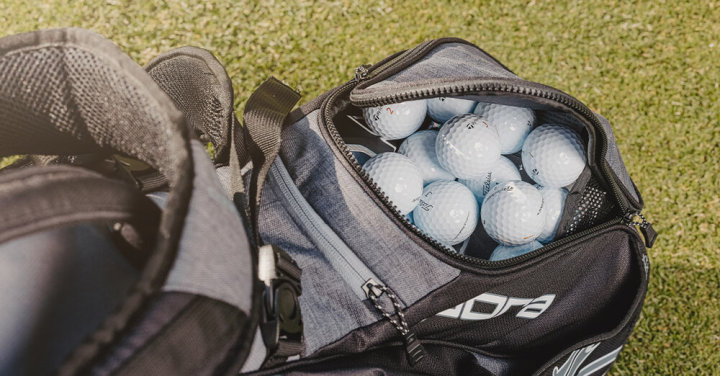Price guarantee - 14 days
Free returns
All prices are incl. VAT & Custom
Free shipping over £50

Which golfball should I choose?
Do you find it difficult to choose the right golf ball? Don't worry—we're here to help. After all, the ball is the only piece of equipment used for every single shot, making it a crucial factor in achieving great results.
How Much Spin Does It Give You? Is the ball flight what you're looking for? Do you swing fast enough to compress the ball at impact? These are important questions to ask yourself—or our staff—when choosing a golf ball.
At Dormy, we categorize golf balls into four groups: tour balls, spin/control balls, distance balls, and women's golf balls. Below, we’ll explain how each type performs and guide you in choosing the right ball for your game.
Tour Balls
As the name suggests, this type of golf ball is designed for highly skilled players—typically those with the fastest swings who compress the ball the most at impact. Compression refers to how much the golf ball is squeezed when struck, which is why tour balls have multiple layers beneath their cover.
You may have heard discussions about a ball’s compression rating. Tour balls typically range between 90–110, making them best suited for players with higher swing speeds. If you’re not a powerful hitter, you won’t fully benefit from the features of a tour ball, so you may want to consider a spin/control ball instead. That said, this isn’t a strict rule—if you like the firmer feel of a tour ball and it performs well for you, it could still be the right choice.
Tour balls have a urethane cover, a durable yet relatively soft material that provides a pleasant feel on impact. The biggest advantage of a tour ball is in the short game, where it generates significantly more spin than other types of golf balls. Professional players choose tour balls primarily for their control around the greens—the ability to land an iron shot close to the pin or execute a wedge shot with backspin is crucial at their level.
Examples of tour balls: Titleist Pro V1, TaylorMade TP5, Srixon Z-Star.
Spin/Control Balls
Spin/control balls are the category we recommend for most golfers. With a lower compression rating (typically 50–80), they are easier for the average player to compress at impact compared to tour balls, allowing them to fully utilize their features.
These balls don’t generate quite as much spin around the greens as tour balls, but they still provide plenty of control for most players. Additionally, their lower spin in long shots can actually be an advantage, as it reduces side spin and makes it easier to keep the ball on target.
This is the golf ball category that suits the majority of golfers in terms of both performance and price.
Examples of spin/control balls: Titleist Tour Speed, Mizuno RB 566, Bridgestone E12 Contact.
Distance Balls
There was a time when distance balls were known as "rocks"—but that’s no longer the case. On the contrary, modern distance balls are designed to feel soft off the clubface while also providing extra yardage.
Most distance balls are two-piece balls, featuring an ionomer cover and a large core. Compared to other golf ball categories, distance balls contain less technology and generate less spin in the air. This results in a higher launch angle, longer carry, and more roll upon landing.
Many distance balls have a compression below 50, making them ideal for players with lower swing speeds. In addition to extra distance, the reduced spin helps keep shots straighter, making them a great choice for players who struggle with slicing.
Example of a distance ball: Wilson Duo Soft.
Women’s Golf Balls
Women’s golf balls are the softest balls on the market, designed primarily to match the average female golfer’s swing speed. Their construction and performance share many similarities with distance balls.
One key feature that many women appreciate is that these balls feel soft and comfortable at impact. Repeatedly hitting a ball that is too firm can feel unpleasant, so women’s golf balls provide a more forgiving feel in all situations—including putting.
Examples of women’s golf balls: TaylorMade Kalea, Wilson Duo Soft Lady.

A few tips to keep in mind when buying golf balls:
1. Let go of the prestige
Just because the world stars you see on TV play with a certain ball model, doesn’t automatically mean it’s the best choice for you as well. It may absolutely be the best for many, but the trend is that more and more players are switching to a softer golf ball, so dare to try it too. Give a spin/control or distance ball a chance, and you’ll be pleasantly surprised by how good it actually is.
2. Don’t switch balls
Test out a few different models properly. Once you’ve found a model you like, keep practicing with that ball model and don’t use those worn-out found balls at the bottom of your bag. Getting used to one specific ball model will be valuable in the long run when you know exactly how the ball behaves in all situations. Once you’ve found your favorite, stick with it!
3. Play with fresh balls
Sure, the ball you found in the left rough on hole five while searching for your own looks just fine and might last a few more shots, but it still doesn’t compare to the feeling of opening a fresh 3-pack of your favorite ball. Plus, an older, worn-out ball wears down your clubs and grooves more than a new ball does. New balls pay off over time.
You know that you can sort the balls by category on our website? This way, you'll only see balls that suit you and your swing.